Home -
Austria -
Benelux -
Channel Islands -
France & Monaco -
Germany -
Poland -
Russia -
Spain -
Sweden -
Switzerland -
Turkey -
United Kingdom -
United States
Back to reviews in Italy
 I do not think I shall ever exhaust the riches of Umbria. It has 800 mediaeval towns and villages and each has something to offer the civilized traveller. The region’s capital is Perugia, whose inhabitants (and visitors) are much blessed. Italians, particularly of the younger sort, are much given to the passeggiata – the evening promenade which is part fashion show, part opportunity for gossip and part match-making exercise. I enjoy taking part myself, in as much sartorial style as I can muster. It is a particular delight in Perugia, for the ritual is performed along the wide corso Vannucci, one of the most beautiful thoroughfares in Europe. This is the central axis of the magnificent old town, perched upon its hill near the centre of the city. The corso Vannucci runs into the piazza Italia, and here – exactly where everyone of taste and discernment wants to be – there is my sort of hotel. The Brufani Palace – with its stone fireplaces, columns, parquet floors and ancient paintings – exudes patrician refinement. And that is why I love it.
I do not think I shall ever exhaust the riches of Umbria. It has 800 mediaeval towns and villages and each has something to offer the civilized traveller. The region’s capital is Perugia, whose inhabitants (and visitors) are much blessed. Italians, particularly of the younger sort, are much given to the passeggiata – the evening promenade which is part fashion show, part opportunity for gossip and part match-making exercise. I enjoy taking part myself, in as much sartorial style as I can muster. It is a particular delight in Perugia, for the ritual is performed along the wide corso Vannucci, one of the most beautiful thoroughfares in Europe. This is the central axis of the magnificent old town, perched upon its hill near the centre of the city. The corso Vannucci runs into the piazza Italia, and here – exactly where everyone of taste and discernment wants to be – there is my sort of hotel. The Brufani Palace – with its stone fireplaces, columns, parquet floors and ancient paintings – exudes patrician refinement. And that is why I love it.
Opened in 1884, this solid and handsome pile was built on the ruins of a papal palace. Indeed, the historical antecedents go back further – for, through the waters of the swimming pool, cunningly inserted into the mediaeval vaults (pictured), there can be glimpsed ruins which date back to the Etruscan period. And there is recent history here, too. It was from this very hotel that, in 1922, the March on Rome of the 30,000 began – an event might be said to have changed the subsequent history of the world. However, it is something else which comes to mind when I check in at the Reception desk. For the framed photographs show Queen Elizabeth the Queen Mother, and were taken when she was staying at the hotel in 1992. Our last Queen Empress looks very happy, as I always do when I arrive at the Brufani Palace. Indeed, if you look at the picture of me with the General Manager, the charming and efficient Stefano Chiesa, you will see the face of a happy man.
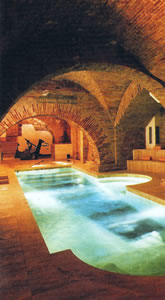
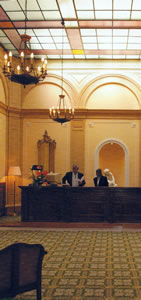

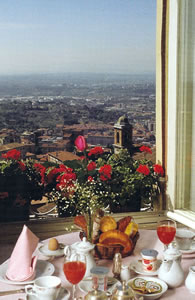
Up on the second floor, I liked my first impression of room 235 (a suite, as are 35 of the hotel’s 94 rooms, and therefore 883 euros a night, bed and breakfast for two). Its colours were rich and warm: gold (for the silk damask on the walls), pink (for the carpet) and crimson (for the velvet of the sofa and the easy chair). From its balcony I could gaze at a view (pictured) which encompassed ancient churches and a wide sweep of Umbrian hills. Cross-banded woods and ormolu mounts on the furniture and the peacocks in the oil painting set the style in the 18th century. Table lamps and gilt wall lights provided restful illumination. In the bathroom of grey and dark green marble, I found two wash basins, a bidet, a tub of proper length (with a jacuzzi facility), a pair of scales and a separate shower and bright spotlights. In the adjacent dressing area was the private safe for my diamond cuff-links. In this handsome, air-conditioned apartment, each night, in a bed made specially soft for me, within sheets of finest linen, I slept the sleep of the righteous.
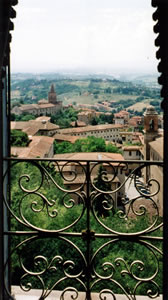

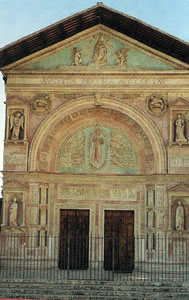
As you would expect, Perugia is packed with priceless paintings, many of them by the great master, Perugino. Some of the best are so near to the hotel that even my tired legs could reach them without benefit of taxi. But I would urge you to make sure that you go to see one architectural masterpiece of the Renaissance which is a little further away, and for which – given the steep streets – I decided that a car was necessary. The façade of the Oratory of San Bernardino by Agostino di Duccio (1461) is breathtaking in its perfect symmetry. The picture of it I here reproduce does it no justice whatever.
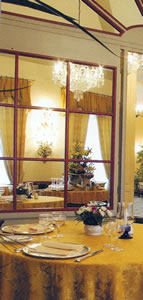
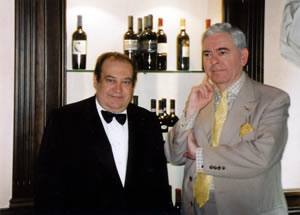 In Italy, grand hotels often use rooms of considerable grandeur for breakfast. This is a practice of which I entirely approve. Thus it was that I broke my fast in Perugia each morning next to columns of red marble and beneath a chandelier of white and gold wood of monumental proportions. In these dignified surroundings I secured – from the extensive buffet – bacon, Rice Crispies, chunks of pineapple and melon, and delicious fruit tarts, washed down with coffee served in white porcelain pots and by my concluding cappuccini. (A tip: ask one of the charming waiters – smartly dressed in black waistcoats and bow-ties, and presided over by the excellent Franco – for a glass of freshly squeezed orange juice. It will be absolutely delicious.)
In Italy, grand hotels often use rooms of considerable grandeur for breakfast. This is a practice of which I entirely approve. Thus it was that I broke my fast in Perugia each morning next to columns of red marble and beneath a chandelier of white and gold wood of monumental proportions. In these dignified surroundings I secured – from the extensive buffet – bacon, Rice Crispies, chunks of pineapple and melon, and delicious fruit tarts, washed down with coffee served in white porcelain pots and by my concluding cappuccini. (A tip: ask one of the charming waiters – smartly dressed in black waistcoats and bow-ties, and presided over by the excellent Franco – for a glass of freshly squeezed orange juice. It will be absolutely delicious.)
The restaurant used for lunch and dinner, called Collins, is the adjacent chamber. It is named after George Collins, a nephew of the founder, Giacomo Brufani. This is smaller and brightly lit. Its floor is covered with antique parquet and a large stone fireplace dominates the proceedings. Around this handsome room, excellent and efficient waiters move to good purpose and lift silver domes with the proper degree of panache. They are under the watchful eye of the fine maitre d’ Emidio Cavalletti, with whom I was happy to have my photograph taken – a picture which I now present to you. Mr Cavalletti is a mine of information, not only about his menu and his wine list but also about all things Umbrian. He also has fond memories of the visit of the Queen Mother.
Chef Marco Faiella uses good ingredients in a straightforward and intelligent way, and produce dishes (of generous size) which are hugely enjoyable. From my own dinners I will recall for you some of the highlights. Porcini mushroom terrine with cream of chickpeas and truffle was luscious and flavoursome. A parmesan flan (in the manner of a small soufflé) with sliced ham from Norcia was equally subtle and delicious. Pappardelle with venison ragout brought wonderfully soft pasta. Indeed, the pasta here is so good that it presents rather a dangerous temptation – to which I eagerly succumbed, when I ate up every scrap of a massive helping of cheese-filled tortellone with pigeon and cherry tomatoes, and thereafter could do no justice at all to a gorgeous piece of tender beef fillet, which arrived with mountains of fried potatoes and onions. Still, I was able to reclaim my credentials as a carnivore on the subsequent evening by devouring with relish a plate of sliced loin of lamb with truffle-scented butter. (Allow 70-80 euros for four courses.)

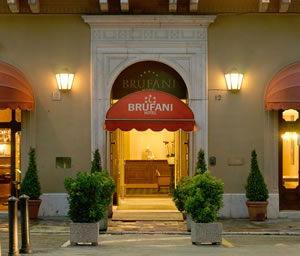

The wine list has 130 offerings and is essentially Italian, although there are some tempting champagnes, like Krug Grande Cuvée (250 euros). Prices range from 18€ for a red from Assisi (Sportoletti) to 300€ for Cristal champagne. Other bottles to catch my eye were: 2008 Planeta chardonnay (45€), 2005 Planeta merlot (55€), 2001 Tignanello (130€) and 2003 Solaia (180€). I drank Umbrian wines, recommended by Mr Cavalletti. Allow me to recommend two of them to you, for they show that it is possible to drink well here at very low cost. The 2008 Grechetto, ‘Il Moggio’, Goretti, for just 22 euros, yielded lemons, lychees and melons. And the 2009 Trasimeno, ‘Oscano’, Carini, for 20 euros. was even better – laden with ripe black fruit, and ideal for the beef. This was good drinking.
I began by observing that the inhabitants of Perugia and its visitors are much blessed. Not only do benedictions pour upon them from the city’s beautiful works of art: rich extra blessings are imparted to those who stay at this well-run hotel. Its location, its history, its style, its comfort, its food and its level of service make The Brufani Palace a real credit to its great city. I am already looking forward to my return.


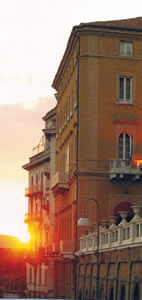
Piazza Italia 12, 06100 Perugia, Italy.
Telephone +39 075 5732 541
Fax +39 075 5720 210
Email: brufanipalace@sinahotels.it
www.brufanipalace.com
Double rooms from 325 euros, breakfast extra.
Check the hotel website for special offers